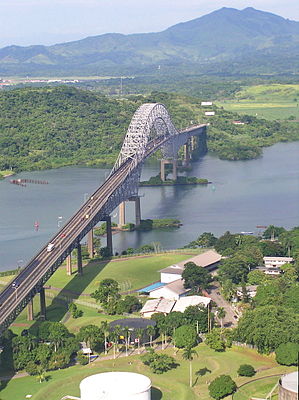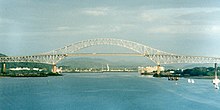Puente de las Americas
Coordinates: 8 ° 56 '35 " N , 79 ° 33' 54" W.
| Puente de las Americas | ||
|---|---|---|
| use | Motor vehicles | |
| Crossing of | Panama Canal | |
| place | Balboa , Panama | |
| construction | Cantilever bridge | |
| overall length | 1654 m | |
| height | 117 m | |
| Clear height | 61.3 m | |
| vehicles per day | 35,000 (2004) | |
| building-costs | 20 million US dollars | |
| start of building | December 23, 1958 | |
| completion | May 16, 1962 | |
| opening | October 12, 1962 | |
| planner | Sverdrup & Parcel | |
| location | ||
|
|
||
The Puente de las Américas , formerly mostly called Thatcher Ferry Bridge , in English the Bridge of the Americas ( North and South America ) is a road bridge in Panama . It spans the Panama Canal and thus connects the capital Panama City with the western part of the country. It is usually only used by motor vehicles.
Until the Puente Centenario was built in 2004, it was the only fixed road connection between North and South America and thus an important part of the Panamericana .
location
The bridge crosses the southern, Pacific entrance to the Panama Canal near Balboa, a suburb of Panama City. The actual beginning of the Panama Canal formed by the Miraflores locks is a little more than 6 km further inland. An expressway coming from the capital is already led around 600 m from the shore at a height of 20 m above sea level on the long access ramp, which climbs over a green slope filled with oil tanks to the actual bridge. On the opposite, western side, a ramp leads to the expressway to Arraiján, which begins about 30 m above the canal, and continues to the western parts of the country.
The bridge is roughly where the Thatcher Ferry used to be.
Surname
The former Thatcher Ferry was named after Maurice H. Thatcher , a former head of civil administration in the Canal Zone . Maurice H. Thatcher was Chief of the Department of Civil Administration of the Canal Zone from May 13, 1910 to August 8, 1913, a time during which he gained widespread recognition by the local population. As a member of the United States House of Representatives from 1922 to 1933, he continued to campaign for Panamanian affairs and introduced laws to start the ferry service, which later became known under his name, and to build the road to Arraiján. Under John F. Kennedy , during the construction of the bridge, a law was passed in 1961 to name it Thatcher Ferry Bridge . The pen with which Kennedy signed the law was later given to Maurice H. Thatcher as a token of appreciation. It is noteworthy, however, that the bridge was not named immediately after him, but after the ferry that was replaced by the bridge.
However, the American name was not popular among Panamanians, who preferred to call the bridge Puente de las Américas . On October 2nd, 1962, just 10 days before the opening ceremonies, the National Assembly of Panama therefore decided that the bridge should be called Puente de las Américas and only this name should be used.
At the opening ceremony, the representative of the United States Under Secretary of State George W. Ball did not use this name as such, but stated that the bridge in the course of the Panamericana was really a bridge between the Americas.
In practice, however, the name change did not take place until 1979, when US control of the Panama Canal zone ended.
description
The Puente de las Américas is a total of 1654 m (5425 ft) long and about 15 m wide. It has four lanes and a narrow sidewalk each, but is used almost exclusively by motor vehicles that are brought to it on long expressways. The occasional long-distance cyclist crossing the bridge creates significant obstructions to general, heavy traffic. The narrow sidewalks between the outer, inwardly curved railing and the guardrail of the lanes are only used by the maintenance staff of the bridge.
The spanned by a large sheet main opening in the center of the channel has a span of a total of 343.81 m (1128 ft) and an internal height of 61.3 m (201 ft) above MHW (Middle High water) . The apex of the steel arch is 117 m (384 ft) above sea level.
The bridge seems to consist of a large, uniform steel truss structure that bulges in the middle to form a large arch. But technically it is a cantilever bridge , whose large, consisting of steel truss Gerber support from both sides of 42 m in the main opening protrude and a 259 m long false arch construction carry. With this construction of the large, middle arch, the horizontal forces pushing outwards are neutralized by the two heavy steel girders acting as tension bands , which are attached under the suspended roadway below ( Langerscher beams ). This arch construction ends on both sides where the roadway and the horizontal tension beams meet the inclined steel girders of the bridge arch. The main weight of the tannery girders rest high above the entrance to the canal on the concrete pillars, which are protected from collisions with ships by the artificial islands in the canal. The outer ends of the tannery girders rest on the next inland pair of supports. This is followed by the access ramps, which consist of seven steel truss bridges on the eastern side and four such bridges on the western side, all of which are erected on concrete pillars. All concrete pillars are founded on the natural rock, especially the pillars that appear to be on the islands.
The Puente de las Américas was by no means the longest, largest or highest bridge in the world at the time it was built. However, their clearance height as well as their construction height were several meters greater than those of other cantilever bridges.
The cost was around US $ 20 million and was borne entirely by the United States , as the bridge was in what was then the Panama Canal Zone , a territory claimed and administered by the United States between 1903 and 1979 , which was de facto not for that period Belonged to state territory of Panama.
history
The first considerations about a bridge or a tunnel were made in 1913 before the opening of the Panama Canal. The project was also discussed in 1929 and 1937, and in 1941 there were even initial negotiations with a planning office. In 1942 the swing bridge in the Miraflores locks was completed, which was not intended as a replacement for a permanent bridge, but the existence of which made the planning for a permanent bridge appear less urgent. In connection with an agreement on military installations, the US committed itself to Panama to build a bridge or a tunnel after the end of World War II . The project was discussed again and again afterwards, but without concrete consequences. In 1954 it was decided to give preference to a bridge over a tunnel. In the following year, new cost estimates were made. In the Remón-Eisenhower Treaty of 1955, President Rémon again received the US promise to build a bridge. The following year, Eisenhower gave orders for initial measures on a visit to Panama; In 1957 Sverdrup, Parcel & Associates were commissioned with preliminary planning. In 1958 they received the order for the complete planning.
On December 23, 1958, the groundbreaking ceremony took place during a major ceremony by the President of Panama, De la Guardia, and the Governor of the Panama Canal Zone , William E. Potter . The actual construction work began in September 1959. The following year, John F. Beasley Construction Co. of Dallas , Texas received the contract for the steel construction work, for which the steel was supplied from West Germany. On May 16, 1962, the arch was closed by installing a 21 m long steel girder. The grand opening of the bridge took place on October 12, 1962, when Maurice H. Thatcher, now 92, cut the ribbon.
Web links
- The Panama Canal Review: Thatcher Ferry Bridge, linking the Americas (PDF; 2.4 MB). Balboa Heights, CZ, October 5th, 1962
- The Building of a Bridge by CZBrats
- Puente de las Americas. In: Structurae
Individual evidence
- ↑ a b c d e f The Panama Canal Review: Thatcher Ferry Bridge, linking the Americas (PDF; 2.4 MB). Balboa Heights, CZ, October 5, 1962; Retrieved May 6, 2012.
-
↑
«El puente sobre el Canal de Panama llevará el nombre de Puente de las Américas. En todos los documentos públicos se usará exclusivamente ese nombre para identificar dicho puente. Los funcionarios al servicio del Estado panameño rechazarán cualquier documento en donde se mencione el puente con nombre distinto al de "Puente de las Américas. Se enviará copia de esta resolución, con nota de estilo a los cuerpos legislativos del mundo, de suerte que a tododo las partes se le de al puente el nombre escogido por esta augusta cámara, acatando la voluntad expresa del pueblo panameño.Dado
en la ciudad de Panamá a los dos días del mes de octubre de mil novecientos sesenta y dos.El
Presidente,
Jorge Rubén Rosas
El Secretario,
Alberto Arango N. »“The bridge over the Panama Canal will be named Puente de las Américas . In all public documents only this name is used to denote the bridge. Officials in the service of the Panamanian state will reject any document that refers to the bridge by any other name as the Puente de las Américas . Copies of this resolution will be sent with a formal cover letter to all the legislatures of the world so that all will give the bridge the name chosen by this venerable chamber in accordance with the express will of the Panamanian people.
Resolved in Panama City on the second day of October 1962.
President
Jorge Rubén Rosas
Secretary
Alberto Arango N. "- Inauguración del Puente de las Américas on alonsoroy.com - ↑ Inauguración del Puente de las Américas ( Memento of the original dated February 6, 2006 in the Internet Archive ) Info: The archive link was inserted automatically and has not yet been checked. Please check the original and archive link according to the instructions and then remove this notice. on alonsoroy.com, accessed May 10, 2012
- ↑ For comparison: Verrazzano-Narrows Bridge , New York: 66–69 m; Golden Gate Bridge , San Francisco: 67 m; Bosphorus Bridges , Istanbul: 64 m; Storebæltsbroen , Great Belt: 65 m; Köhlbrand Bridge , Port of Hamburg: 53 m.
- ↑ Many suspension bridges were longer and higher back then. If you compare the Puente de las Américas only with other cantilever bridges , the Forth Bridge (1890) is much longer, the Québec Bridge (1919) has a larger span, but both are not quite as high as the Puente de las Américas.
- ↑ Excavation and concrete work as well as steel construction work were outsourced.




